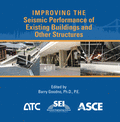A Practical Model for Beam-Column Connection Behavior in Reinforced Concrete Frames
Publication: Improving the Seismic Performance of Existing Buildings and Other Structures
Abstract
In reinforced concrete frames, earthquake loading results in damage to beam-column joints that reduces frame stiffness and strength. This can significantly impact frame performance. Joints in existing frames may be subjected to large shear stresses, have large bond stress demands, and have little or no transverse reinforcement. To assess the seismic performance of existing concrete frames, engineers require models that can accurately predict the behavior of joints with a wide range of design parameters and that are easily implemented in commercial software. In this study, a database of 45 planar interior beam-column joints was used to evaluate two types of joint models. First, rigid offset models, which are acceptable for linear analyses, were considered. The rigid offset models recommended in the ASCE/SEI Standard 41-06 were evaluated, and a modified approach to provide improved prediction of the yield displacement was evaluated. Second, a nonlinear model was developed to enable simulation of progressing stiffness and strength loss using commercial design/analysis software; this model was verified for a range of joint designs. In the proposed nonlinear model, the beam-element plastic hinge is assumed to represent two nonlinear hinges in series. The first hinge represents the flexural response of the beam, and the second represents the nonlinear response of the joint. The beam flexural hinge is defined by the traditional moment-curvature response of the beam section and a newly developed rotation limit at which strength loss is predicted. The joint hinge is bilinear, with stiffnesses calibrated to accurately predict measured response, and includes a rotation limit at which strength loss initiates in the joint. Using this approach, nonlinear joint response is, ultimately, simulated by modifying the beam-element plastic hinges. The proposed model accurately predicts the load-displacement response of frame sub-assemblages including accurately predicting the mechanism that determines response: flexural yielding of the beam or failure of the joint.
Get full access to this article
View all available purchase options and get full access to this chapter.
Information & Authors
Information
Published In
Copyright
© 2010 American Society of Civil Engineers.
History
Published online: Apr 26, 2012
Authors
Metrics & Citations
Metrics
Citations
Download citation
If you have the appropriate software installed, you can download article citation data to the citation manager of your choice. Simply select your manager software from the list below and click Download.
